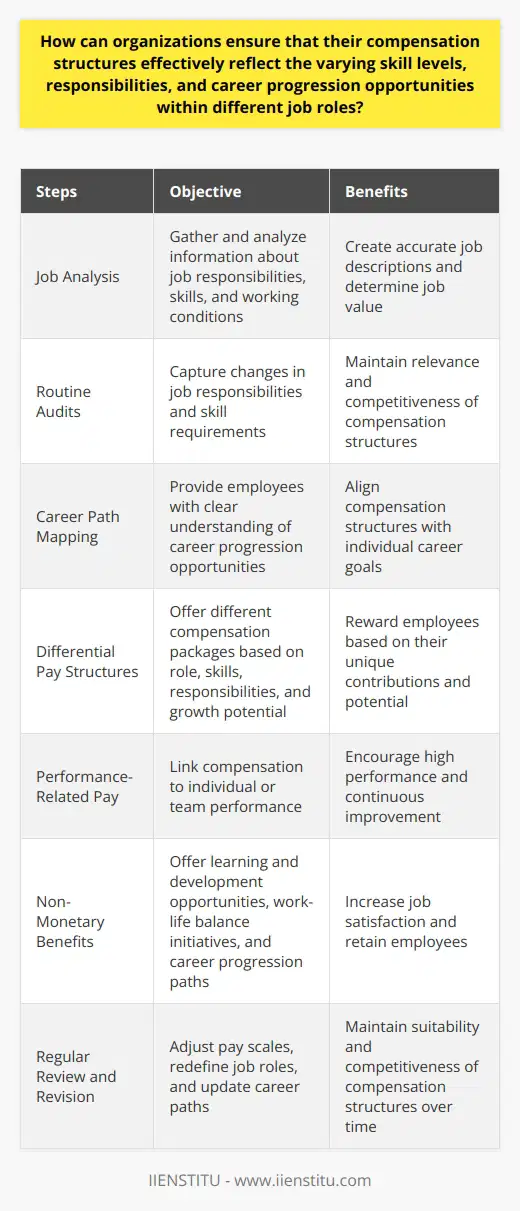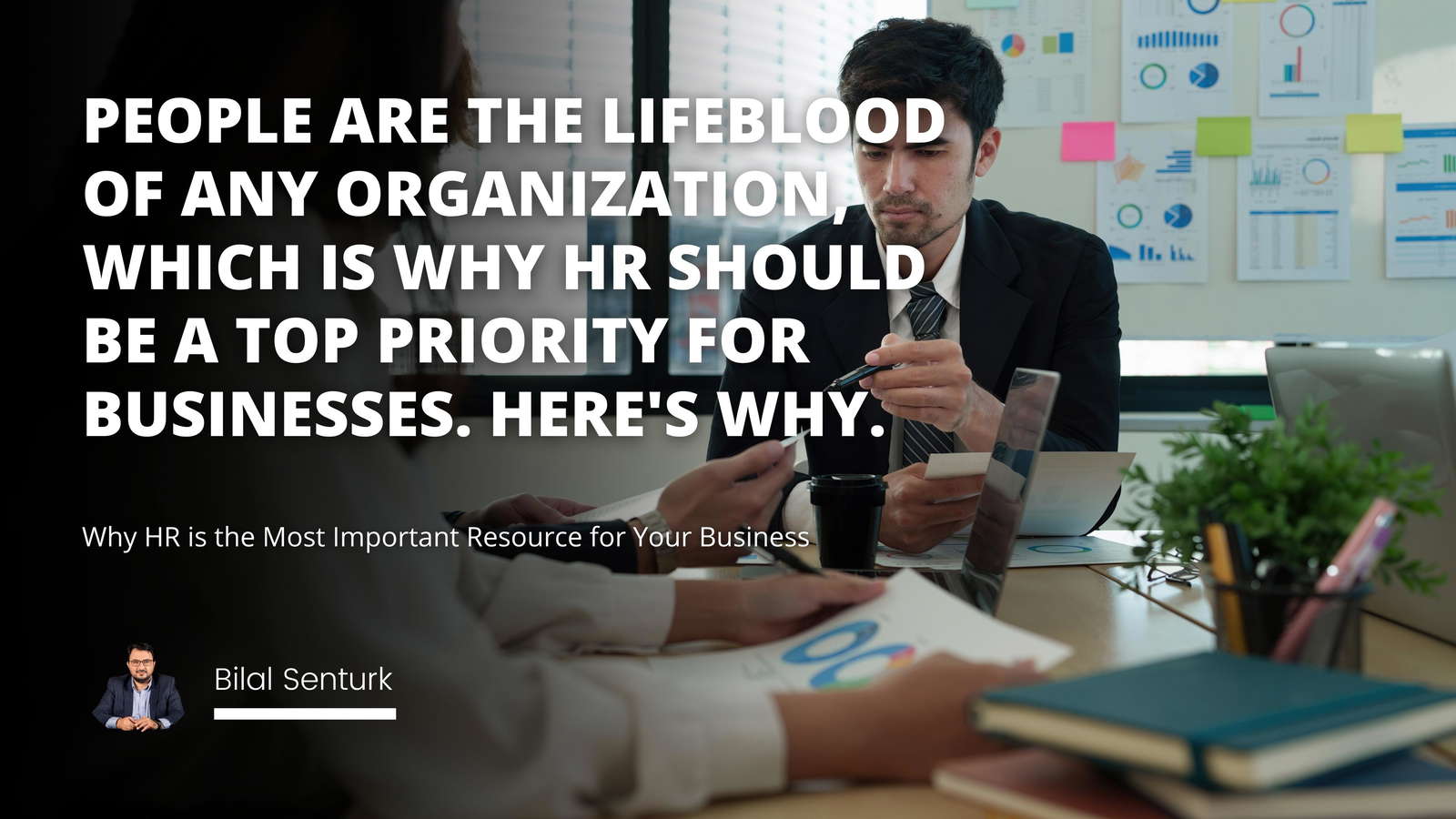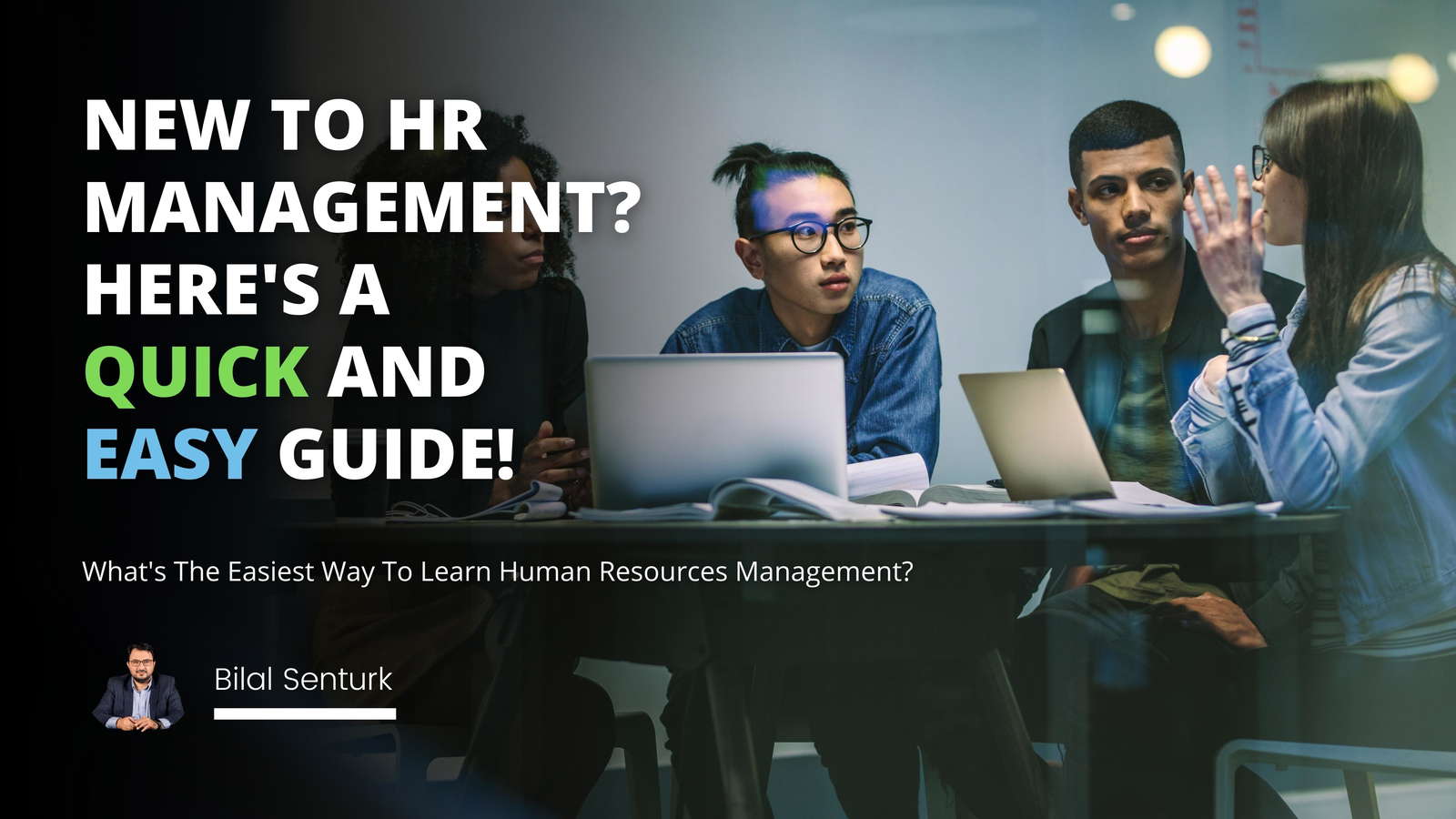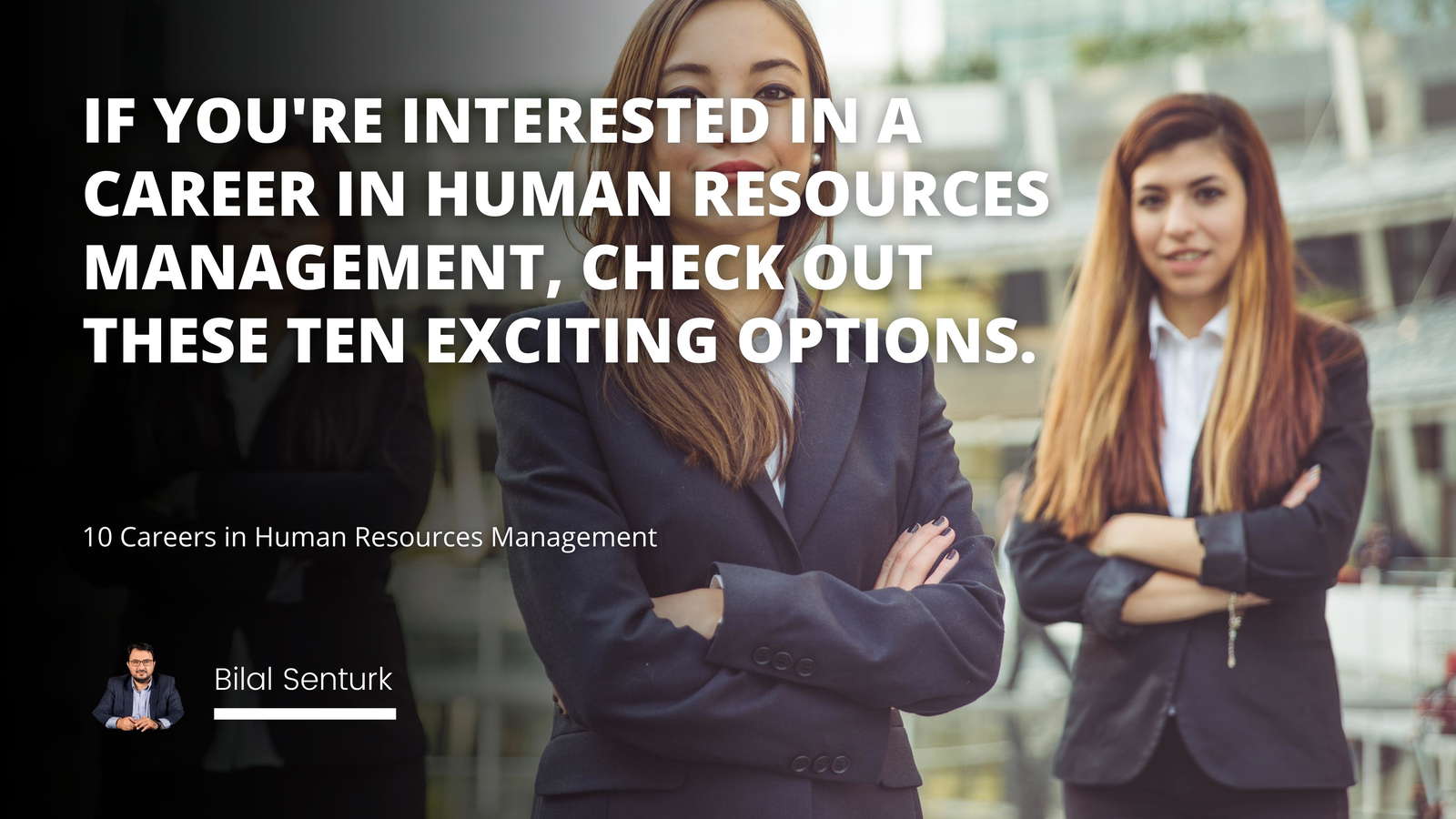
Overview of Compensation and Benefits
Types of Compensation and Benefits Packages
Designing an Effective Employee Compensation & Benefits Package
Methodology for Designing an Effective Package
Employee compensation and benefits packages are crucial to an organization's strategy. Therefore, organizations need to create compensation and benefits plans that are attractive to potential employees and tailored to the organizaorganization'sThis blog post will provide a comprehensive overview of the design process for corporate HR when designing packages for employee compensation and benefits.
Overview of Compensation and Benefits
Before delving into the design process for adequate employee compensation and benefits packages, it is helpful to understand what this process entails.
Definition of Compensation and Benefits
At the most basic level, compensation and benefits refer to the various forms of compensation and benefits that an organization can provide its employees. Generally, there are two main types of payment: financial compensation, such as salaries and bonuses, and non-financial compensation, such as vacation days, medical coverage, and job satisfaction. In addition, benefits refer to the non-financial compensatory benefits an organization can provide its employees, such as medical coverage and retirement plans.
Types of Compensation and Benefits Packages
Organizations typically offer different compensation and benefits packages to meet the diverse needs of their employees. Generally, there are three main types of packages: standard containers, which include legal employee compensation and benefits; tailored packages, which are customized to the individual employee; and hybrid packages, which combine elements of both classic and tailored packages.
Designing an Effective Employee Compensation & Benefits Package
Once an organization has decided on the type of package, it wishes to offer its employees; it must enter the design stage. Here, several steps must be completed before creating a compelling package.
Identifying the Organization's Needs
The first step in designing an effective package is identifying the organization's needs. This involves assessing the organization's financial and non-financial resources, as well as considering the organization's goals. Once the organization's needs have been identified, the HR team can explore and develop appropriate packages to meet these needs.
Identifying the Budget
Once the organization's needs have been identified, the HR team must determine the best available budget for the employee compensation and benefits package cost. This will enable the HR team to build a package that meets the organization's needs while staying within the budget.
Evaluating Competitors' Packages
Another critical step in the design process is to evaluate the packages offered by the organization's competitors. This will allow the HR team to understand better the competitive landscape, which, in turn, will help them design a package that meets the organization's needs and industry standards.
Methodology for Designing an Effective Package
Once the basic steps of the design process have been completed, the HR team can then focus on the methodology for creating a compelling package. This can involve several different methods, depending on the situation.
Choosing the Components
Once the organization's needs and budget have been identified, the HR team must select the package components that best meet the organization's needs. This can involve selecting financial and non-financial components, such as salaries, bonuses, and health coverage.
Developing Value Statements
Value statements are essential for any effective package for employee compensation and benefits. Creating these statements clarifies the box's value for the organization and its employees.
Ensuring Fairness and Equity
Finally, the HR team must ensure the package is fair and equitable for all employees. This can make the parcel competitive and tailored to employees' needs and preferences.
Designing an adequate employee compensation and benefits package is a complex process, but it is essential for any successful organization. Therefore, it is crucial for organizations to understand the critical elements of the design process and to choose the components of their package that best meet the organization's needs. By following the best practice guidelines outlined above, organizations can create packages that attract potential employees and maximize the value of their organization.
Compensation and benefits are essential pieces of the puzzle for a better corporate culture. Without them, the foundation is incomplete.
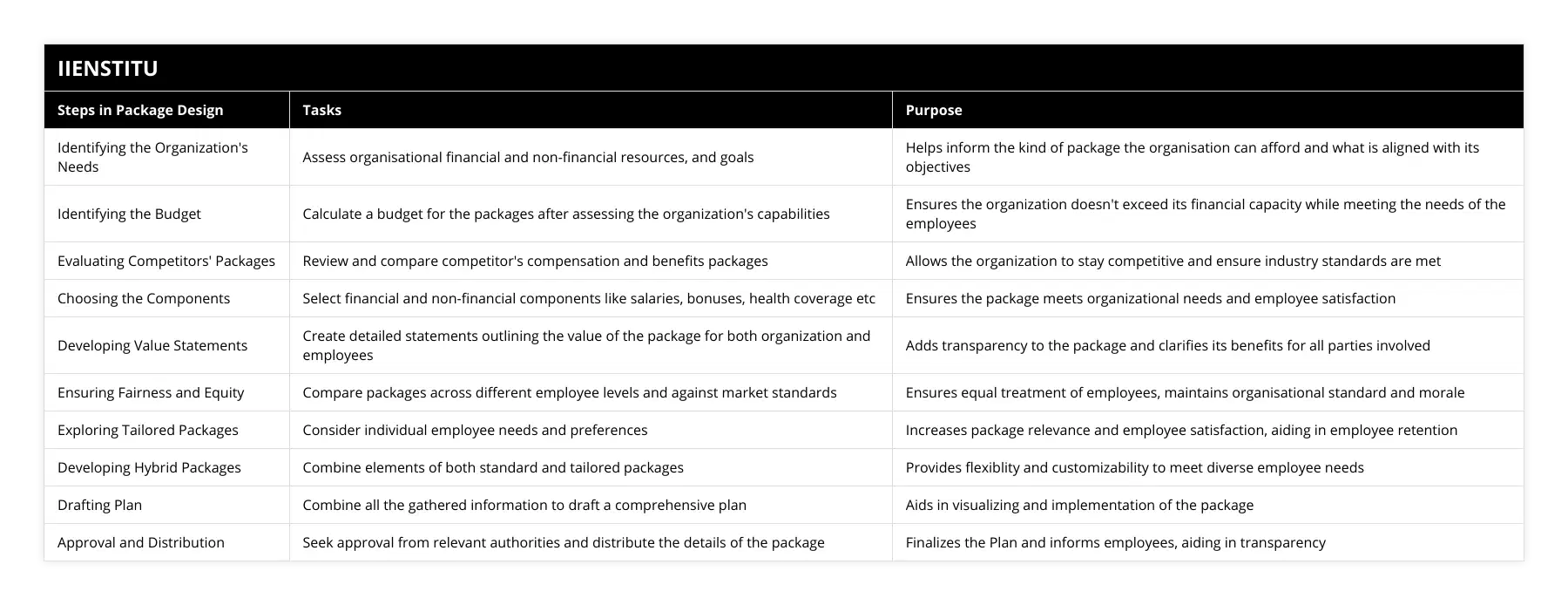
Frequently Asked Questions
What factors should be taken into account when designing an effective employee compensation and benefits package?
Employers must consider many factors when designing an adequate employee compensation and benefits package, from the types of benefits to offer to the associated costs. By understanding the needs of employees, tailoring packages to suit their particular circumstances, and assessing the financial implications, employers can craft a package that is both beneficial to the company and attractive to potential and existing employees.
The types of benefits offered will impact both the cost of the package and its attractiveness to candidates. Job seekers often expect essential benefits such as vacation, health and dental insurance, and retirement plans. At the same time, additional perks like gym memberships, company cars, and tuition assistance may entice higher-caliber personnel. Companies should assess their industry, region, and budgetary factors to determine the best mix of benefits.
Implementing a compensation and benefits package should be very well-thought-out to ensure maximum use to employees and maximum cost efficiency for employers. To do this, employers should consider the structure of their packages, from the frequency of payouts to eligibility criteria for different types of benefits. They should also ensure their package fits local laws and regulations, including any minimum wage requirements or tax implications related to particular uses.
An essential part of a successful compensation and benefits package is proper employee communication and education. Employers should ensure that any available options are clearly explained, including how employees can access benefits, how much their contributions will be, and the terms and conditions related to particular uses.
In summary, when designing an employee compensation and benefits package, employers should consider the needs of employees, the cost of providing benefits, and local laws and regulations. In addition, a comprehensive employee education and communication plan must ensure maximum benefit and cost efficiency. Considering these factors will allow employers to craft a package that is an effective recruiting tool and provides happy and engaged employees.
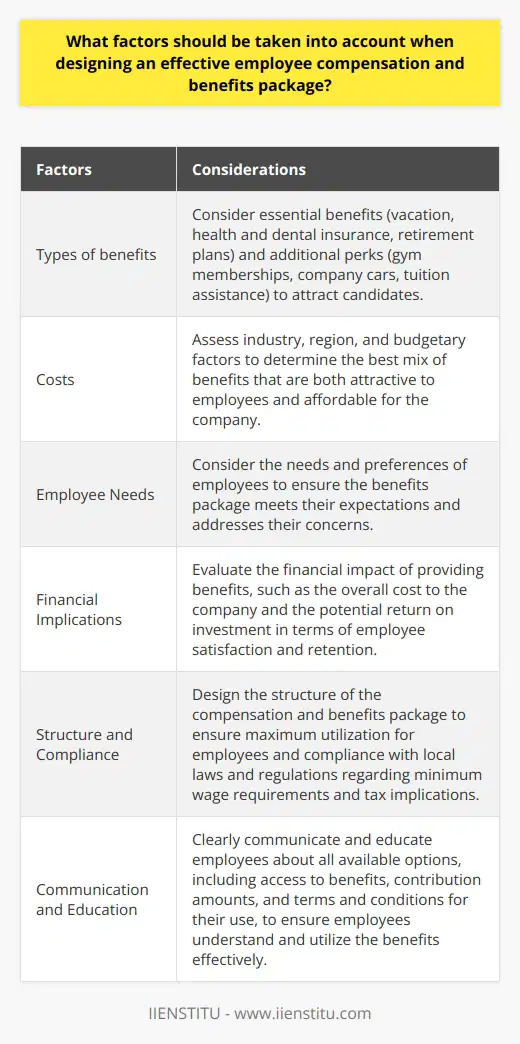
What techniques should be used to ensure that employee compensation and benefits are fair and equitable?
In today’s increasingly competitive job market, providing employees with fair and equitable compensation and benefits is paramount. Organizations that strive to reward and recognize their employees while protecting employee rights can enjoy the help of a more loyal and motivated workforce. Organizations should consider various techniques to ensure fair and equitable employee compensation and benefits, including consistency and communication, analyzing market-based comparisons, and providing multiple benefits.
First and foremost, organizations should strive to maintain consistency and communication regarding employee compensation and benefits. Employers must communicate their salary policies and help ensure that employees know and understand their rights and entitlements. By establishing clear standards and procedures, organizations can ensure that all employees, regardless of race, gender, or other protected identities, are given the same opportunities.
In addition, organizations should analyze market-based comparisons to ensure that employee compensation and benefits align with industry standards. By analyzing the data, organizations can ensure that they provide comparable salaries and benefits whenever possible. While this approach may not be feasible for all employers, it can help organizations gain insight into the appropriate salary ranges to recruit, retain, and reward talent.
Finally, organizations should strive to provide a diverse and comprehensive range of benefits. This involves offering benefits to meet various employee needs, such as health insurance, retirement plans, and employee assistance programs. Employers can ensure employees are rewarded and recognized for their service by providing many benefits and opportunities.
In conclusion, organizations should maintain consistency and communication, analyze market-based comparisons, and provide various benefits packages to ensure that employee compensation and benefits are fair and equitable. These techniques can help organizations to create a workplace where all employees are valued and respected.

What guidelines must be followed when determining the tone of voice used to communicate employee compensation and benefits information?
When communicating with employees about their compensation and benefits package, employers must maintain a professional and consistent tone of voice to ensure that employees feel respected and valued.
Determining the tone of voice used to communicate employee compensation and benefits information should be treated with the same care and due diligence as any other communication process. Here are some general guidelines that employers should consider when making such a determination:
Consistency: Employees should be able to expect the same tone of voice in all communications from their employer, whether via email, written letters, or other methods. Providing consistent messaging helps to ensure that the message is accurately conveyed and perceived.
Respectful: The tone of voice used should be respectful and non-judgmental. Employees should not feel their employer is putting them in an uncomfortable position or judging them for their compensation and benefits requests.
Encouraging: The tone of voice should encourage and provide positive reinforcement for employees. Instead of using language that may be intimidating or condescending, employers should offer constructive feedback and guidance to help employees make the best decisions for their needs.
Knowledgeable: Employers should strive to be knowledgeable about employee compensation and benefits. They should use clear, unambiguous, and well-informed language when communicating this information. This will help employees to understand the message and make an informed decision.
Engaging: An engaging and conversational tone of voice will help create an atmosphere of openness and trust. Employers should use this type of language when communicating with employees and ensure that they are responding to questions and concerns promptly.
Employers should consider the above guidelines when determining the tone of voice used to communicate employee compensation and benefits information. By following these guidelines and ensuring that their communications are consistent, respectful, encouraging, knowledgeable, and engaging, employers will provide their employees feel valued and respected.
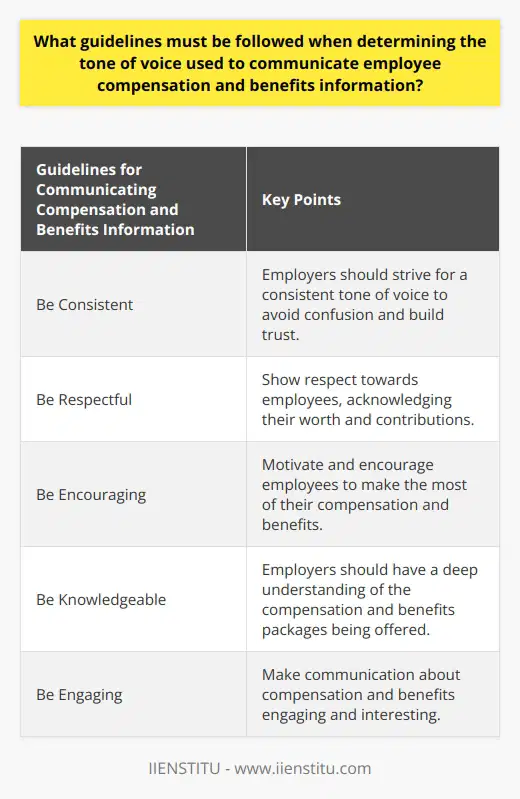
How do you create a compensation structure that balances internal equity and external competitiveness?
Understanding Internal Equity and External Competitiveness
To create a compensation structure that balances internal equity and external competitiveness, it is necessary to understand the fundamental aspects of these two elements. Internal equity refers to the fair distribution of pay within an organization, while external competitiveness pertains to the organization's ability to attract and retain qualified employees among competing organizations.
Conducting Job Analysis and Pay Surveys
A robust and detailed job analysis is required to determine the worth of each position within the organization. This involves the identification of key tasks, level of responsibilities, and requirements for each job. Subsequently, a comprehensive pay survey should be conducted to gather data on prevailing market rates for comparable positions in the sector. This helps to gauge the organization's position within the market, ensuring both competitiveness and fairness.
Establishing Pay Grades and Job Families
Based on the job analysis, positions can be grouped into job families according to their similarities. Job families can then be assigned pay grades, with each grade containing a pay range that takes into consideration both internal equity and external competitiveness. This involves factoring in the relative value of different positions within the organization, as well as ensuring comparable positions in the market are at a similar pay scale.
Implementing Performance-Based Pay
Incorporating performance-based pay as part of the compensation structure allows for rewarding high-performing employees, which in turn fosters motivation, engagement, and retention. This system should be transparent and fair, with clearly established performance measurement criteria and processes in place. Furthermore, ensuring regular feedback and communication with employees promotes a better understanding of their role in contributing to the organization's overall success.
Monitoring and Reviewing Compensation Structure
Constant monitoring and regular reviews of the compensation structure are essential to ensure its continued effectiveness and alignment with the organization's goals. Factors like inflation, changes in market conditions, and the evolving needs of the organization should be taken into consideration when updating the structure. This will help maintain a balance between internal equity and external competitiveness in the long run.
In conclusion, creating a balanced compensation structure necessitates a systematic and well-organized approach, comprising thorough job analysis, pay surveys, pay grade establishment, and performance-based pay implementation, along with continuous evaluation and adjustments. This ensures a fair and competitive work environment that motivates and retains talent within the organization while remaining attractive in the broader marketplace.
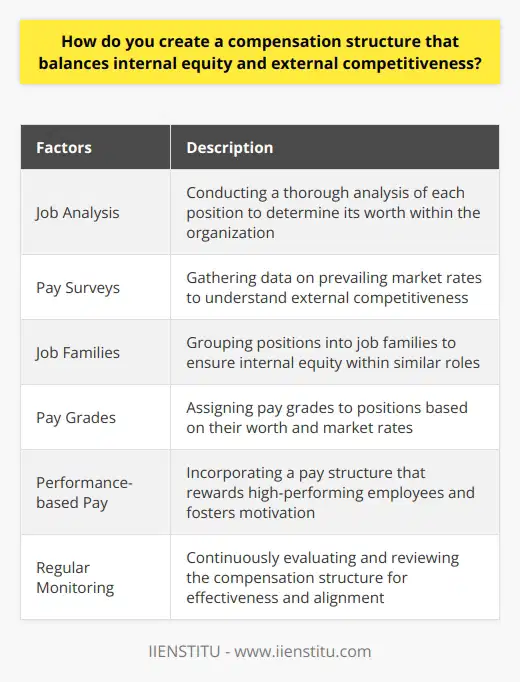
What are some best practices for monitoring and adjusting compensation and benefits programs to respond to market changes and organizational goals?
Understanding Market Changes and Organizational Goals
Monitoring and adjusting compensation and benefits programs is essential for organizations to maintain a competitive position in the market and achieve their strategic goals. To achieve this, companies must follow best practices in compensation management that address both internal and external factors.
Regular Compensation Benchmarking
One of the best practices for monitoring and adjusting compensation and benefits programs is to perform regular compensation benchmarking. This entails comparing an organization's pay structure and benefits offerings with those of competitors within the same industry. By doing this, organizations can identify trends, gaps, and opportunities for improvement in their compensation packages.
Aligning with Organizational Strategy
Another critical aspect of adjusting compensation and benefits programs is ensuring that they align with the company's overall strategic objectives. This can be done by implementing variable pay structures like bonuses, incentives, or stock options to reward employees who contribute significantly to the achievement of company goals. Ensuring that your pay strategies support your strategic objectives can help drive employee engagement and performance.
Engaging in Continuous Improvement
Organizations must also commit to a process of continuous improvement in their compensation and benefits programs, adapting and refining these as needed. This can involve regularly reviewing and updating pay structures, benefits offerings, job classifications, and performance evaluation systems. This ongoing process helps to ensure that the programs remain competitive, equitable, and aligned with the organization's strategic goals.
Involving Stakeholders in Decision Making
To track the effectiveness of the compensation and benefits systems, organizations should involve key stakeholders, such as employees, managers, and executives, in the decision-making process. Collecting feedback from these stakeholders can provide valuable insights on the effectiveness of the programs and suggest potential areas for improvement. Involving stakeholders also helps to foster a sense of ownership and commitment to the success of the organization.
Monitoring Key Performance Indicators (KPIs)
Finally, organizations should use Key Performance Indicators (KPIs) to assess the effectiveness of their compensation and benefits programs. These KPIs can include measures of employee satisfaction, retention rates, turnover, engagement levels, and cost-effectiveness. Tracking these metrics over time helps to determine whether the programs are achieving the desired outcomes and informs necessary adjustments to stay competitive and meet strategic objectives.
In conclusion, organizations should adopt best practices such as regular benchmarking, aligning compensation strategies with company goals, engaging in continuous improvement, involving stakeholders in decision-making, and monitoring key performance indicators to ensure their compensation and benefits programs effectively respond to market changes and organizational objectives.
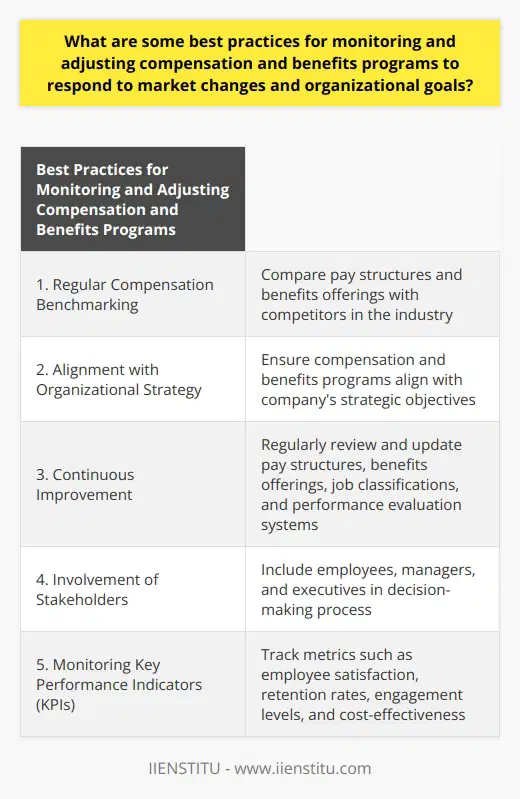
How can HR professionals effectively communicate and negotiate compensation and benefits packages with prospective and current employees?
Understanding Employee Needs
To effectively communicate and negotiate compensation and benefits packages, HR professionals must first understand the needs and preferences of prospective and current employees. They can achieve this by conducting thorough research, including surveys and interviews to gather insights into what employees value most. Such information can help tailor packages to the individual, resulting in increased job satisfaction and reduced turnover.
Establishing Clear Communication Channels
Setting up clear communication channels is crucial for HR professionals when discussing compensation and benefits. This involves choosing the most suitable medium for dialogue, such as face-to-face meetings, phone calls, or email conversations, and ensuring that communication is concise and easy to understand. Avoiding technical jargon and using simple language can help minimize misunderstandings and increase the likelihood of reaching mutually agreeable terms.
Transparency and Trust-building
Being transparent about the organization's compensation practices is critical for building trust with employees. HR professionals must provide detailed explanations of various components of the compensation package, such as base pay, bonuses, and benefits. In addition, they should be open to answering any questions about the rationale for specific pay structures and benefit offerings. Demonstrating candor and honesty can lead to employees feeling confident about their potential remuneration and personal development within the organization.
Negotiating Win-win Solutions
To reach successful agreements, HR professionals should adopt a collaborative approach when negotiating compensation and benefits with employees. Utilizing techniques such as active listening and empathy can help find common ground, while also avoiding aggressive tactics that may create resentment. By focusing on mutual benefits and working towards a win-win solution, both parties can leave the negotiation process feeling satisfied with the final outcome.
Continuous Evaluation and Improvement
Finally, HR professionals should continually assess and refine their communication and negotiation practices to optimize their effectiveness in delivering suitable compensation and benefits packages. Regularly seeking feedback from employees, monitoring industry trends, and adapting to changing circumstances can help ensure that the organization remains competitive and attractive to current and potential talent. This ongoing commitment to improvement will ultimately contribute to better relationships between HR professionals and employees and contribute to the overall success of the company.
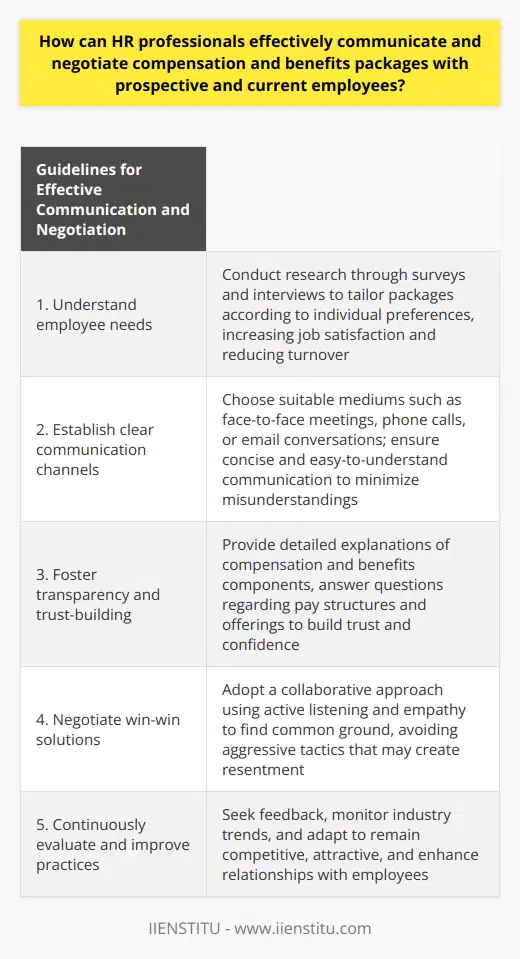
What are the key components to consider when developing a comprehensive HR compensation package?
Critical Elements of HR Compensation Package Development
Understanding Market Trends
When developing a comprehensive human resources (HR) compensation package, it is crucial to comprehend the current market trends. This involves researching salary benchmarks, conducting competitive analyses, and staying up-to-date with industry developments. By doing so, organizations can ensure they provide fair compensation that attracts and retains top talent.
Establishing Job Hierarchies
A well-defined job hierarchy aids in streamlining the compensation process by establishing clear roles and responsibilities. This involves developing job descriptions, analyzing job requirements, and determining the value of each position within the organization. A proper hierarchy will also help to prevent pay inequity and ensure that employees are compensated fairly for their contributions.
Designing Base Pay Structures
The base pay structure is a critical component that reflects the organization's compensation philosophy. This includes determining salary ranges, considering geographical differences, and analyzing cost-of-living factors. The structure should be flexible enough to accommodate individual performance and expertise while maintaining internal equity and competitiveness in the market.
Incorporating Performance-Based Pay
Incorporating performance-based incentives offers opportunities for employees to be rewarded for their hard work and productivity. This can include bonuses, commission, and merit pay adjustments. Utilizing performance-based compensation encourages employees to strive for higher performance levels and aligns their goals with the overall objectives of the organization.
Offering Employee Benefits
While not directly reflected in wages, employee benefits are an essential part of a comprehensive compensation package. These can include healthcare, retirement plans, paid time off, and other perks that supplement the base pay. By offering competitive benefits, employers can enhance employee satisfaction, improve retention rates, and attract top-quality candidates.
Reviewing and Evaluating Compensation Packages Regularly
Regular reviews and evaluations of the compensation package are crucial for maintaining competitiveness in the market and ensuring internal equity. Changes in market conditions, company performance, and individual employee contributions should be considered during these evaluations. By re-assessing their compensation strategy regularly, organizations can address any gaps or discrepancies and remain an appealing employer for prospective and existing talent.
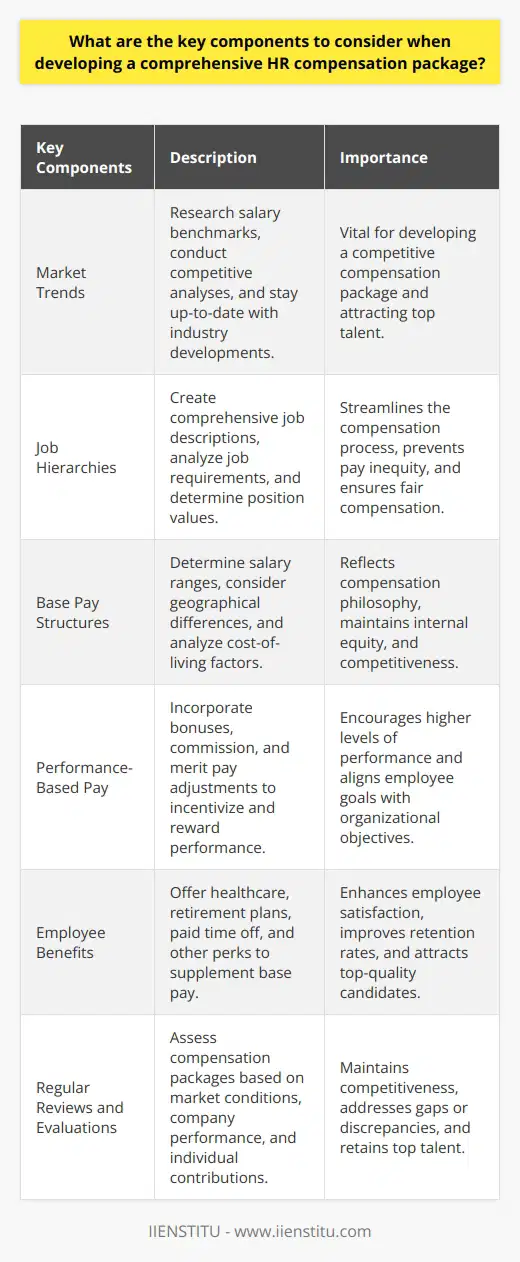
How can an organization ensure alignment between its compensation strategy and overall business objectives?
Understanding Business Objectives
The organization first needs to have a clear understanding of its overall business objectives. A well-defined mission and vision can help guide the company's compensation strategy to ensure it supports the broader goals. Reviewing the objectives regularly and analyzing the market trends can provide valuable insights for revising the compensation strategy as needed.
Employee-centric Compensation Design
To ensure alignment, the organization should design a compensation strategy with employee expectations and motivations in mind. This approach can help in attracting and retaining a talented workforce, which is crucial to achieve business objectives. Incorporating elements such as competitive benchmarking, pay equity, and flexible benefits into the compensation plan can enhance the employee value proposition.
Linking Performance and Rewards
A crucial aspect of aligning compensation with business objectives is emphasizing the link between employee performance and rewards. The organization should establish a robust performance management system that continuously evaluates employee contributions towards defined goals. It should also provide regular feedback to encourage improvement and behavior in line with business objectives. Adopting a merit-based reward system can directly incentivize employees to strive for the company's overall mission and success.
Supporting Employee Development
The compensation strategy should not solely focus on monetary rewards. An organization committed to aligning its compensation with business objectives should also invest in employee development through continuous learning opportunities, skill enhancement programs, and career growth prospects. This approach can foster a culture of continuous improvement and innovation, essential drivers for achieving long-term success in today's fast-paced business environment.
Persistent Communication
Transparent and effective communication plays a vital role in enhancing the correlation between compensation strategy and overall business objectives. Organizations should regularly communicate the strategic intent of their compensation plan to employees, emphasizing the connection between their contributions and the company's success. This continuous dialogue can create a sense of shared responsibility and commitment to the organization's goals.
In conclusion, organizations can ensure alignment between their compensation strategy and overall business objectives by basing their approach on a thorough understanding of their goals, adopting an employee-centric plan, emphasizing the link between performance and rewards, supporting employee development, and maintaining transparent communication. These steps can drive employee engagement, improve retention, and ultimately contribute to the organization’s success.
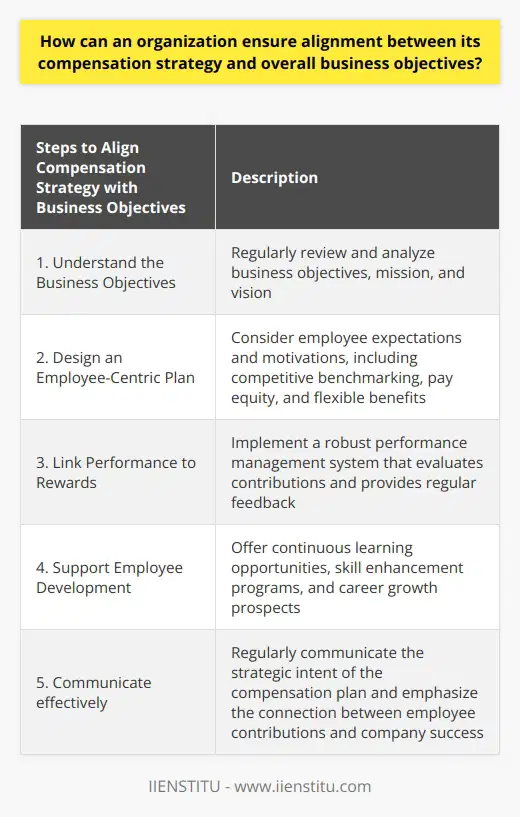
What are some effective approaches to analyzing and benchmarking compensation data within an industry?
Methodologies for Analyzing and Benchmarking Compensation Data
Collecting and Analyzing Data
One effective approach to analyzing and benchmarking compensation data within an industry is to seek external data sources like industry surveys or data from compensation consulting firms. These sources provide information on the market rates for various positions, enabling companies to compare their compensation packages with those of their competitors. Additionally, employers may choose to conduct their internal surveys to gather more specific and accurate data about their industry.
Standardization and Normalization
When dealing with industry compensation data, it is essential to standardize and normalize the data to facilitate accurate comparison. Standardizing involves consistent data representation, which can include using the same currency or measuring the level of experience in years. Normalization allows for the elimination of any potential biases that may affect the comparison in cases where organizations differ in structure or size. This process may involve categorizing positions based on hierarchical levels or utilizing statistical methods to normalize the data, ultimately providing a clearer view of how an organization’s compensation practices stand within the industry.
Appropriate Job Comparison
Selecting appropriate job comparisons for benchmarking can be crucial for an effective analysis of compensation data. To ensure accurate comparisons, jobs should be matched based on factors such as job responsibilities, skills, experience, and education requirements. Additionally, organizations should consider the context of their organization and its strategic objectives when selecting which jobs to benchmark. By focusing on comparable jobs, organizations can better align their compensation practices with those of competitors and industry peers.
Industry-Specific Metrics and Considerations
It is essential to also consider industry-specific metrics during the benchmarking process. Some industries might require additional factors to be analyzed, such as bonuses, profit sharing, or stock options. Employing industry-specific metrics can lead to a more in-depth analysis of compensation practices and help identify possible gaps or areas of improvement. Moreover, organizations should also take into account the market's trends and anticipated changes in demand in the process of setting performance benchmarks and compensation policies.
Periodical Reviews and Updates
Finally, since compensation trends and industry practices can evolve, organizations should consistently review and update their benchmarking practices. Periodical reviews and adjustments enable companies to stay competitive within their respective markets and can help attract, retain, and motivate employees effectively.
In conclusion, effective approaches to analyzing and benchmarking compensation data include collecting and analyzing relevant data, standardization and normalization, appropriate job comparison, industry-specific metrics, and consistent review of the benchmarking practices. By following these approaches, organizations can better align their compensation practices with the industry and ensure they remain competitive in talent attraction and retention.
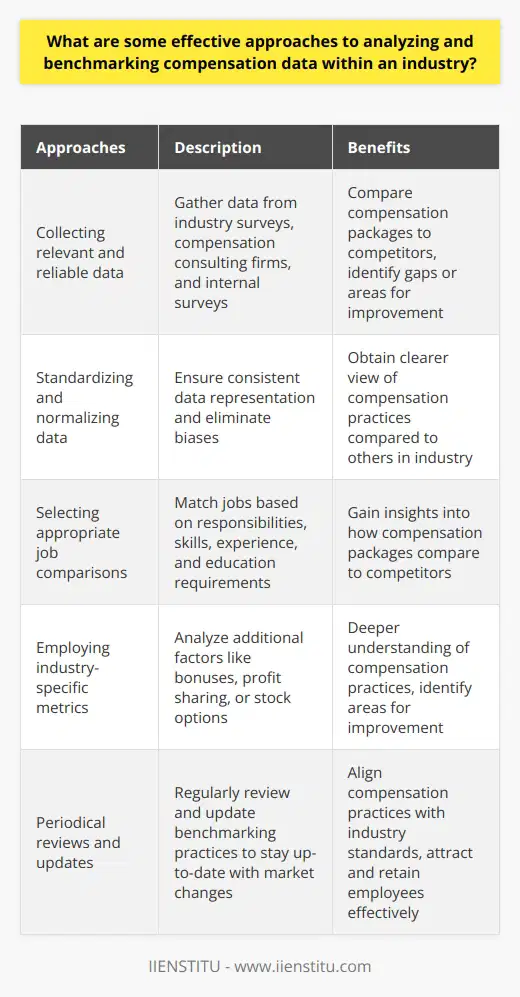
What is the role of job evaluation in the development of a compensation strategy?
Role of Job Evaluation in Compensation Strategy
Understanding Job Evaluation
Job evaluation plays a crucial role in the development of a compensation strategy by providing an unbiased, systematic approach to determining the relative value and worth of different jobs within an organization. Essentially, it is a method of comparing and ranking the various positions based on specific criteria, such as skill level, responsibilities, and required qualifications.
Aligning Internal and External Equity
One of the primary objectives of job evaluation is to ensure both internal and external equity in employee compensation. Internal equity refers to the fair distribution of pay based on the relative worth of each job within an organization, while external equity refers to offering competitive pay levels compared to the external labor market. Job evaluation helps organizations achieve these goals by identifying discrepancies in pay scales and establishing a clear hierarchy of positions.
Identifying Gaps and Priorities
Job evaluation assists organizations in addressing any gaps in their pay structures by identifying positions with overlapping responsibilities or unclear differentiation. This enables the development of a more robust and streamlined compensation strategy, ensuring that employees are appropriately rewarded for their specific roles and responsibilities. Additionally, job evaluation highlights areas where organizations may need to prioritize investments in talent development or workforce planning.
Attracting and Retaining Talent
A well-executed job evaluation process is critical for attracting and retaining top talent, as it ensures that compensation is directly linked to an employee's worth within the organization. A comprehensive compensation strategy developed through job evaluation not only provides competitive remuneration but also helps offer other forms of rewards and recognition tailored to individual employee needs and preferences. This holistic approach to compensation encourages employee engagement and loyalty, thereby reducing turnover and its associated costs.
Facilitating Performance Management
Lastly, job evaluation supports effective performance management by providing clear expectations and benchmarks for employees. A clear understanding of job requirements and expectations informs the development of performance measurement criteria that can be directly linked to the organization's compensation strategy. This alignment helps employees understand the basis of their compensation and motivates them to strive for improvements, ultimately benefiting the organization's overall performance and growth.
In conclusion, job evaluation serves as the foundation for an effective compensation strategy by ensuring internal and external equity, identifying gaps and priorities, attracting and retaining talent, and facilitating performance management. A thorough job evaluation process can ultimately contribute to a more motivated, engaged, and high-performing workforce that drives an organization's success.
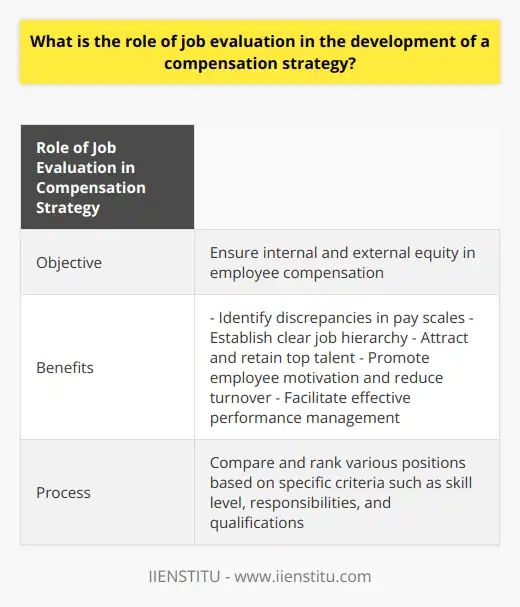
How can organizations effectively utilize performance management systems to inform and enhance employee compensation and benefits decisions?
Performance Management and Employee Compensation
Organizations can effectively utilize performance management systems (PMS) to inform and enhance employee compensation and benefits decisions in several ways. When properly implemented, PMS helps organizations recognize employees' contributions, making it easier to reward them accordingly.
Establishing Clear Performance Metrics
First, organizations should establish clear performance metrics that align with their strategic goals. These metrics should be specific, measurable, achievable, relevant, and time-bound (SMART). By setting SMART performance targets, employees have a clear understanding of expectations, allowing for accurate evaluation and reward allocation.
Conducting Regular Performance Reviews
Regular performance reviews are essential in monitoring employees' progress and ensuring that their efforts are recognized. These evaluations provide valuable insights to guide compensation and benefits decisions. An employee who consistently exceeds performance expectations may be eligible for a bonus or promotion, whereas underperforming employees may require feedback and support to improve.
Linking Performance to Compensation
To enhance employee motivation, organizations should align performance outcomes with compensation and benefits. This linkage creates a transparent and fair system, incentivizing individuals to pursue their objectives. A well-structured incentive plan should balance between individual and team-based rewards to promote collaboration and collective success.
Promoting Open Communication
Open communication between employees and management fosters trust and transparency. Employees should feel comfortable discussing their performance, concerns, and suggestions for improvement. In turn, management should offer constructive feedback and guidance. This exchange of information enhances understanding and allows organizations to make well-informed employee compensation and benefits decisions.
Adapting to Changing Contexts
Effective utilization of PMS requires organizations to adapt their performance measurement and reward systems to changing contexts. By understanding external factors such as market trends and economic conditions, organizations can revise their metrics and incentive structures to maintain competitiveness and meet employees' evolving expectations.
In conclusion, performance management systems, when implemented and utilized effectively, can inform and enhance employee compensation and benefits decisions. By establishing clear performance metrics, conducting regular performance reviews, linking performance with rewards, promoting open communication, and adapting to changing contexts, organizations can better recognize and reward employee contributions, ensuring a motivated and successful workforce.
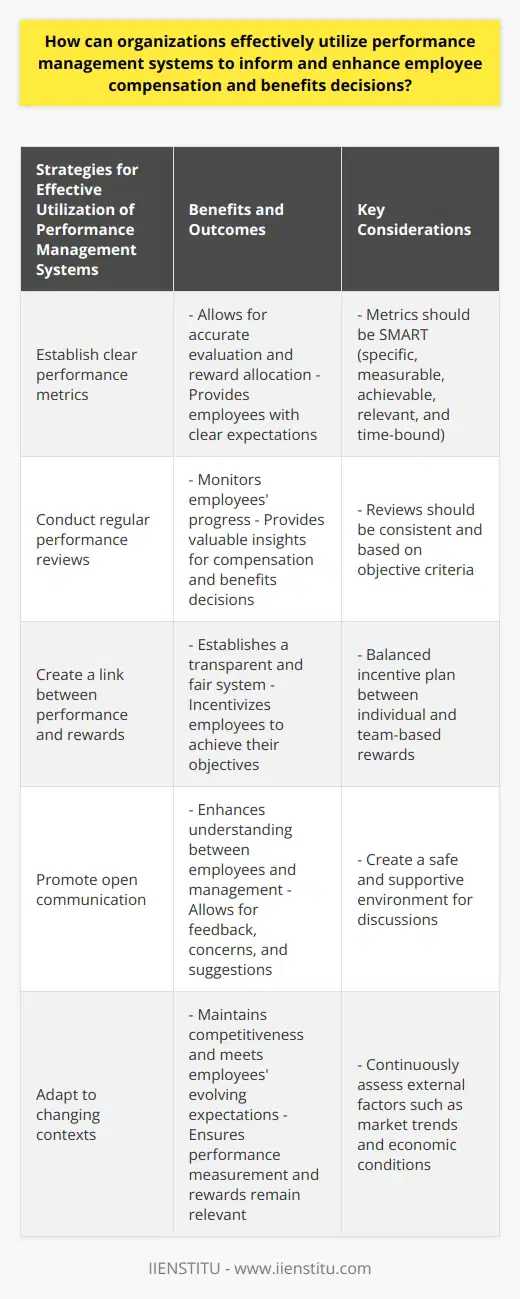
What measures can be taken to address and prevent issues of pay equity and pay discrimination within an organization's compensation plan?
**Addressing Pay Equity**
To address pay equity and prevent pay discrimination within an organization's compensation plan, employers must first analyze their current compensation system. This process involves reviewing job descriptions, assessing their value within the organization, and identifying potential disparities.
**Equal Pay for Equal Work**
One measure that can be implemented is ensuring equal pay for equal work. By conducting regular salary audits and comparing salaries by position, experience, and department, organizations can identify discrepancies and make adjustments accordingly. This avoids wage gaps that may exist due to gender or other protected classes.
**Transparent Pay Scales**
Establishing transparent pay scales can also contribute to equity in compensation. By providing clear guidelines for salary ranges and merit increases, employees can better understand how their compensation is determined. This transparency helps to foster trust and eliminates the possibility of unfair treatment.
**Implementing Bias-Free Policies**
Another key action is the development of bias-free policies and procedures when determining compensation. By strictly adhering to these policies, employers can create a fair process that rewards employees based on their performance and avoids discrimination.
**Continuous Evaluation of Compensation Strategies**
Regularly evaluating and updating compensation strategies is essential for addressing pay equity. As market conditions and industry standards change, it is crucial to adjust compensation structures accordingly. Ensuring that pay scales remain competitive and fair helps maintain equity within the organization.
**Employee Training and Communication**
Finally, organizations must invest in employee training and communication efforts to both prevent pay discrimination and address existing equity issues. By educating employees on the importance of pay equity and promoting dialogue around compensation, organizations can foster a more inclusive and equitable culture.
In conclusion, addressing pay equity and pay discrimination requires a multifaceted approach, including analyzing current compensation systems, ensuring equal pay for equal work, establishing transparent pay scales, implementing bias-free policies, continuously evaluating compensation strategies, and promoting employee training and communication. By taking these measures, organizations can foster a fair and inclusive compensation plan, thus preventing pay discrimination and promoting pay equity.

What are the best practices for striking the right balance between fixed and variable compensation elements in a rewards package?
Finding the Optimal Compensation Mix
To strike the right balance between fixed and variable compensation elements in a rewards package, companies must consider several best practices. By implementing a well-designed compensation structure, employers can attract and retain top talent while ensuring motivation and increased productivity among the workforce.
Understanding Employee Needs
First and foremost, businesses should comprehend the diverse needs of employees. A combination of salary, bonuses, commissions, and stock options should be tailored to meet the risk tolerance, job roles, and preferences of different workers. Tailored packages can address employees' desires for security and growth potential more effectively than one-size-fits-all approaches.
Aligning with Organizational Goals
An effective compensation plan aligns with a company's overall objectives and performance metrics. By linking variable compensation components to individual and collective performance, employers can create a direct connection between rewards and desired results. This alignment encourages employees to actively contribute to the organization's long-term success.
Benchmarking and Market Analysis
Regularly reviewing and updating compensation mixes based on market data is essential to remain competitive. Companies should leverage industry benchmarks and regional statistics to ensure their packages are attractive to current and potential employees. This data-driven approach allows businesses to identify trends and adjust their rewards packages accordingly.
Considering Fiscal Implications
Employers must carefully evaluate the fiscal consequences of implementing specific fixed and variable compensation elements. In this regard, companies should consider tax implications, financial constraints, and potential future expenses. These considerations can help ensure that compensation plans are sustainable and provide the desired return on investment.
Measuring and Evaluating Success
Lastly, companies should continuously evaluate the effectiveness of their compensation strategies by gathering and analyzing employee feedback, collecting metrics on employee satisfaction, and monitoring attrition rates. This ongoing evaluation process can identify areas for improvement and allow businesses to make necessary adjustments to maintain an optimal balance of fixed and variable components.
In conclusion, striking the right balance between fixed and variable compensation elements entails understanding employee needs, aligning with organizational objectives, conducting market analysis, considering financial implications, and regularly measuring and evaluating success. By following these best practices, companies can design a rewards package that motivates, retains, and attracts top talent, ultimately supporting long-term growth and success.
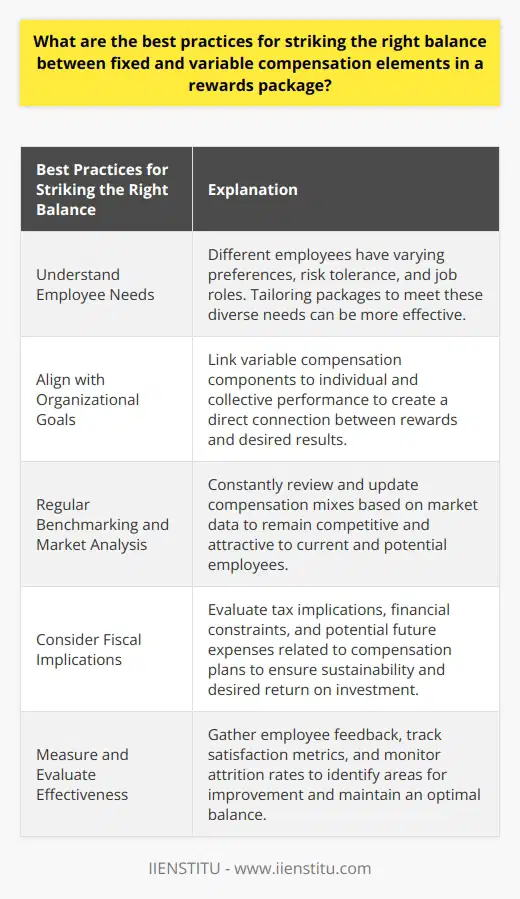
How can organizations effectively manage and adapt their compensation plans to align with changing employee expectations and industry trends?
Understanding Employee Expectations
To effectively manage and adapt their compensation plans, organizations need to begin by understanding the changing expectations of their workforce. This includes gauging employee preferences for a variety of compensation elements such as fixed salary, variable pay, and non-monetary rewards.
Incorporating Industry Trends
Next, organizations must keep abreast of industry trends and consider benchmarking their compensation plans against competitors. This enables organizations to remain competitive in attracting and retaining talent, and ensures that compensation is aligned with changing industry best practices.
Implementing a Flexible Compensation Structure
In response to the evolving needs and preferences of employees, organizations can adopt a flexible compensation structure that caters to individual needs. This may include offering customizable benefits packages, alternative work arrangements, and career development opportunities, which allow employees to create a personalized work experience that meets their own unique requirements.
Continuous Review and Improvement
Regularly reviewing and updating compensation plans is crucial for organizations to keep pace with rapidly changing employee expectations and industry trends. This involves conducting periodic compensation assessments and soliciting employee feedback to identify areas of improvement and implement necessary adjustments.
Fostering Transparent Communication
Transparent communication is key in managing employees' expectations around compensation. Organizations should develop a clear compensation philosophy, openly communicate this to employees, and ensure that compensation decisions are made based on objective criteria.
Leveraging Technology for Efficient Compensation Management
Lastly, organizations can utilize technology to effectively manage and adapt their compensation plans. This may involve adopting compensation management software, automating data collection and analysis processes, and applying data-driven insights to inform compensation decisions.
By understanding employee expectations, incorporating industry trends, implementing a flexible compensation structure, conducting regular reviews, fostering transparent communication, and leveraging technology, organizations can ensure that their compensation plans remain relevant and aligned with the needs of their employees and industry best practices.
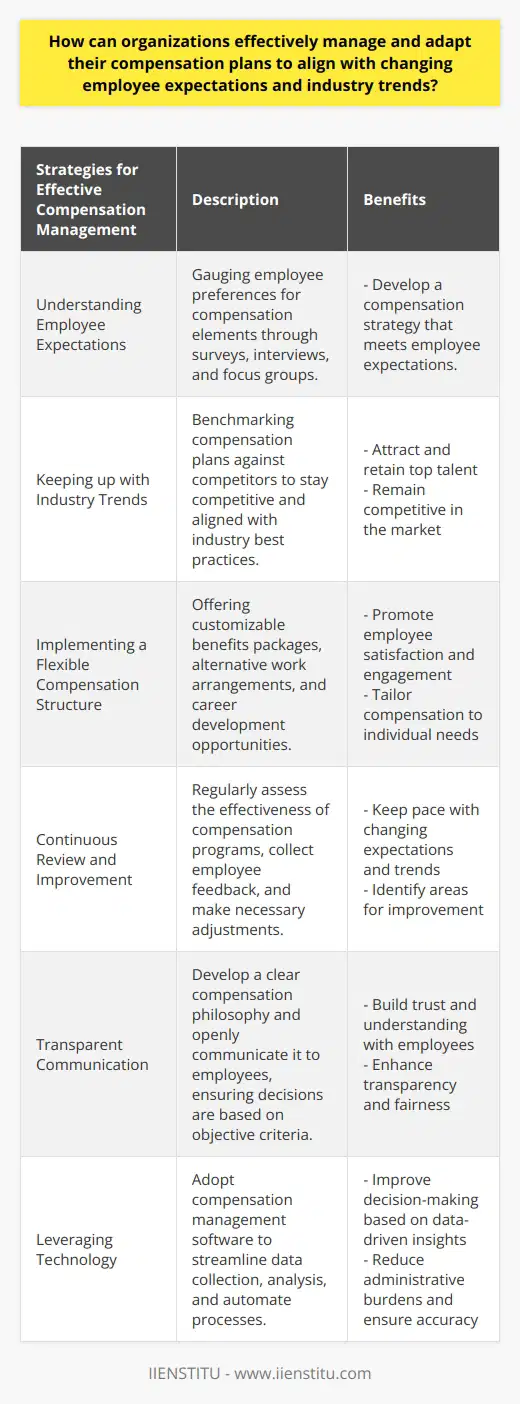
What role do non-monetary benefits and recognition play in a competitive HR compensation package, and how can they be effectively integrated into an organization's overall rewards strategy?
Role of Non-Monetary Benefits and Recognition in Compensation Packages
Non-monetary benefits and recognition are essential components of a competitive Human Resource (HR) compensation package, enhancing employee satisfaction and retention. These elements can increase the attractiveness of an organization's rewards strategy, encouraging top talent to join and remain with a company.
Employee Motivation and Performance
Offering non-monetary benefits, such as flexible work arrangements, professional development opportunities, and health services enhances employee motivation and job satisfaction. Furthermore, recognizing employees' accomplishments and contributions through formal recognition programs, praising their work, and offering promotions and advancement opportunities can significantly influence their performance and commitment to an organization.
Integration into Overall Rewards Strategy
To effectively integrate non-monetary benefits and recognition into an organization's rewards strategy, employers must first identify their employees' unique needs and preferences. Regular employee surveys and feedback channels can provide valuable insights to design tailored benefits and recognition programs. Moreover, organizations should establish clear and transparent criteria for recognition to avoid favoritism and ensure fairness in acknowledging employees' achievements.
Communication and Visibility of Benefits
Transparent communication of available non-monetary benefits and recognition programs maintains employees’ awareness of the organization's support and investment in their well-being. It is essential to provide easy access to information regarding these offerings, along with examples of employee achievements and recognition, through the company's internal communication channels, such as newsletters, intranet, or mobile apps.
Fostering a Culture of Recognition and Appreciation
Creating a culture that emphasizes the importance of recognizing and appreciating employees' hard work and contributions bolsters the effectiveness of non-monetary benefits and recognition programs. This can be achieved by training leaders to recognize and openly acknowledge their teams' achievements and providing employees with opportunities to recognize their peers, further nurturing a supportive and appreciative work environment.
Periodic Assessment of Impact and Adjustments
Regular evaluations of non-monetary benefits and recognition programs to measure their impact on employee satisfaction, retention, and performance are crucial in ensuring their effectiveness. Organizations should incorporate employee feedback and analyze relevant metrics to identify potential improvements or adjustments, striving to maintain a competitive edge in their HR compensation packages.
To sum up, non-monetary benefits and recognition play a pivotal role in a competitive HR compensation package, driving employee satisfaction and performance. Effectively integrating these components into an organization's rewards strategy entails understanding employee needs, transparent communication, fostering a culture of appreciation, and regularly evaluating program effectiveness.
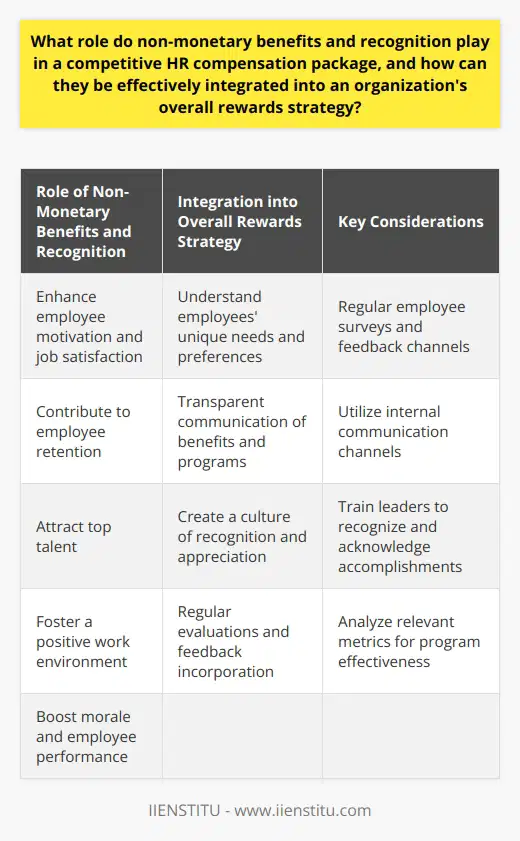
How do you design a compensation package that effectively attracts, retains, and motivates employees while maintaining a balanced budget?
Understanding Employees' Needs
A well-structured compensation package is a potent tool to attract, retain, and motivate employees. It all begins with understanding your employees' needs and desires. Prioritize resources to ascertain what kind of benefits will serve to motivate your employees the most.
Balancing Compensation and Budget
Finding a balance between offering competitive compensation and managing budgets often presents a challenge. However, setting clear and realistic financial parameters at the outset is key in effectively designing a compensation package that doesn't jeopardize your budget.
Utilizing a Mix of Benefits
A compensation package should not just include base salary. It should consist of a mix of benefits, including bonuses, insurance, retirement plans, stock options, or professional development opportunities amongst others. Such a mix caters to employees' diverse needs and ensures that the package appeals to a wide range of talent.
Prioritizing Equity and Fairness
Fairness in compensation is crucial as it impacts employees' perception of an organization and their motivation levels. Regularly comparing your company's compensation packages with industry standards helps ensure they are competitive and fair.
Promoting a Performance-based Compensation Model
Implementing a performance-based compensation model is an excellent way to motivate employees. By linking performance and pay, you motivate employees to work towards achieving goals and objectives, which benefits both the individual and the organization.
Investing in Non-monetary Benefits
Economic constraints often limit a company's ability to increase salaries. Non-monetary benefits such as flexible working hours, work-life balance initiatives, training opportunities, and a positive work environment can serve as powerful motivators.
Regular Reviews and Transparency
Constant evaluation and feedback communication about compensation helps in maintaining a satisfied workforce. Employees value transparency about how the organization determines compensation.
In conclusion, designing an appealing compensation package is a balancing act but an achievable one with careful planning and a strategic approach.
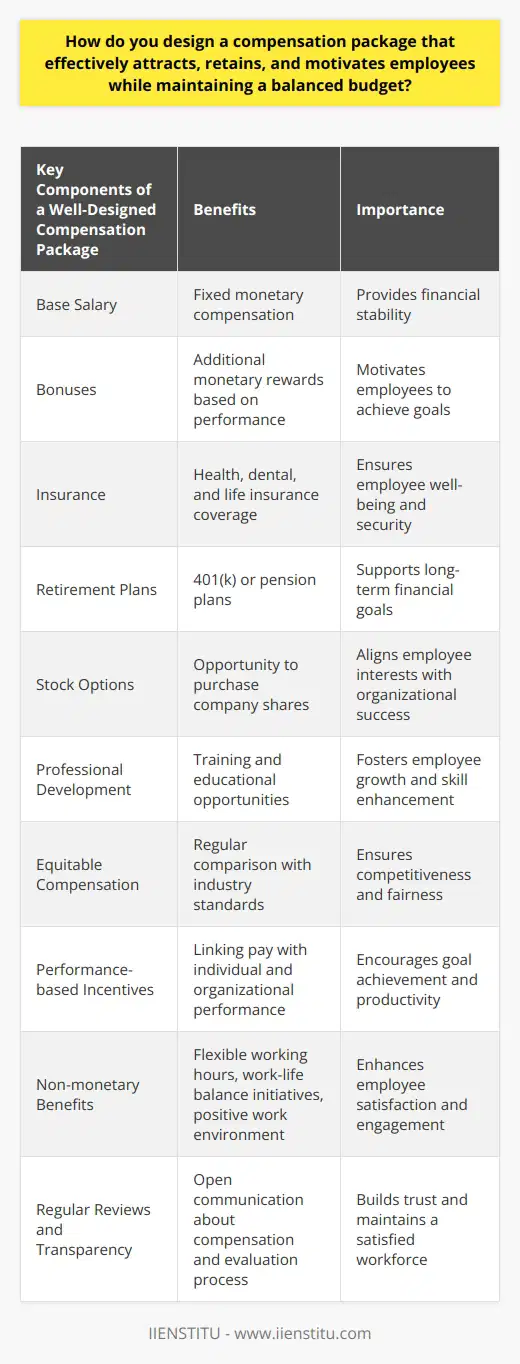
What are the key factors to consider when determining the optimal mix of monetary and non-monetary elements in an employee benefits package?
Understanding Employee Needs
The foremost factor to consider in creating a balanced benefits package is recognizing the needs and desires of the employees. These needs can include, health benefits, retirement plans, vacation days, or even the flexibility to work remotely. It's key to engage with the workforce and discover what they value most.
Industry Standards
Along with understanding employee desires, you also need to consider industry standards. What your competitors are offering can essentially shape employee expectations. Hence, it's crucial to stay consistent and competitive in your benefits package.
Financial Considerations
The financial capabilities of the company will significantly impact the benefits design. Both monetary and non-monetary perks come at a cost. Therefore, the benefits package must be financially sustainable for the business.
Effects on Retention and Recruitment
Benefits play a crucial role in attracting and retaining skilled employees. A carefully designed package will help improve job satisfaction, enhance motivation, and reduce employee turnover. Therefore, the effects on recruitment and retention are essential factors to consider.
Legal Obligations
It's also crucial to understand what employment laws state about entitlements and benefits. Legal requirements often define the minimum standards a company needs to deliver.
Benefits Administration
Administration is another essential factor to consider. The more complex your benefits package, the greater the administration cost. Therefore, you should offer benefits that the company can feasibly manage.
Employee Performance
Finally, the consideration should be the relationship between employee performance and benefits. For benefits to be effective, they should motivate employees to perform well. The ideal benefits package would foster a culture of high performance.
In conclusion, the optimal mix of monetary and non-monetary benefits will be dependent on several key factors. Among them are understanding employee needs and industry standards, considering the company's financial situation, the effects on recruitment and retention of employees, the company's legal obligations, its ability to administer the benefits, and the impact of these benefits on employee performance.

How can organizations ensure that their compensation structures effectively reflect the varying skill levels, responsibilities, and career progression opportunities within different job roles?
Understanding Job Roles
For organizations to ensure their compensation structures reflect varying skill levels, responsibilities, and career progression opportunities, they first need to have a clear understanding of different job roles. They can achieve this through job analysis, auditing, and mapping out career paths.
Conducting Job Analysis
Job analysis entails gathering, documenting, and analyzing information about the responsibilities, tasks, necessary skills, and working conditions of jobs. This information is vital in creating a comprehensive job description and determining the job's value within the organization.
Routinely Auditing Job Roles
Organizations should also conduct routine audits of their job roles. This allows them to capture any changes in job responsibilities and skill requirements over time. Such assessments help to maintain relevant and competitive compensation structures.
Mapping Out Career Paths
Mapping out career paths involves outlining specific job progression possibilities within an organization. This exercise gives an overview of how employees can advance their careers within the organization based on their career objectives, performance, and competencies.
Creating Differential Pay Structures
With a clear understanding of job roles, organizations can then develop differential pay structures. These structures offer varying compensation packages based on an employee's role, skills, responsibilities, and career progression prospects.
Incorporating Performance-Related Pay
Incorporating performance-related pay into compensation structures can also reflect varying skill levels and responsibilities. This rewards high-performing employees and motivates all employees to improve their performance.
Offering Non-Monetary Benefits
Offering non-monetary benefits such as learning and development opportunities, work-life balance, and career progression opportunities also forms a part of a comprehensive compensation package. These elements can weigh heavily for employees, often valued just as much, if not more, than monetary compensation.
Regularly Reviewing Compensation Structures
Finally, organizations should regularly review and revise their compensation structures to ensure they remain suitable and competitive. This includes adjusting pay scales, redefining job roles, and updating career paths to reflect changes in market trends, cost of living, and skills demand. This practice ensures compensation structures retain their effectiveness and relevance.
